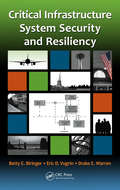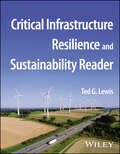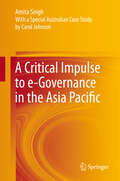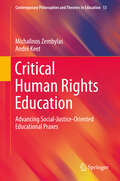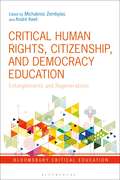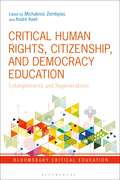- Table View
- List View
Critical Infrastructures, Key Resources, Key Assets: Risk, Vulnerability, Resilience, Fragility, and Perception Governance (Topics in Safety, Risk, Reliability and Quality #34)
by Adrian V. Gheorghe Dan V. Vamanu Polinpapilinho F. Katina Roland PulferIn the face of increasing failures, comments attributed to Albert Einstein loom large: “We cannot solve our problems with the same thinking we used when we created them.” There is a pervasive feeling that any attempt to make sense of the current terrain of complex systems must involve thinking outside the box and originating unconventional approaches that integrate organizational, managerial, social, political, cultural, and human aspects and their interactions.This textbook offers research-based models and tools for diagnosing and predicting the behavior of complex techno-socio-economic systems in the domain of critical infrastructures, key resources, key assets and the open bazaar of space, undersea, and below-ground systems. These models exemplify emblematic models in physics, within which the critical infrastructures, as well as society itself and its paraphernalia, share the profile of many-body systems featuring cooperative phenomena and phase transitions – the latter usually felt as disruptive occurrences.The book and its models focus on the analytics of real-life-business actors, including policy-makers, financiers and insurers, industry managers, and emergency responders.
Critical Infrastructure System Security and Resiliency
by Betty Biringer Eric Vugrin Drake WarrenSecurity protections for critical infrastructure nodes are intended to minimize the risks resulting from an initiating event, whether it is an intentional malevolent act or a natural hazard. With an emphasis on protecting an infrastructure's ability to perform its mission or function, Critical Infrastructure System Security and Resiliency presents
Critical Infrastructure Resilience and Sustainability Reader
by Ted G. LewisCritical Infrastructure Resilience and Sustainability Reader Identify and protect critical infrastructure from a wide variety of threats In Critical Infrastructure Resilience and Sustainability Reader, Ted G. Lewis delivers a clear and compelling discussion of what infrastructure requires protection, how to protect it, and the consequences of failure. Through the book, you’ll examine the intersection of cybersecurity, climate change, and sustainability as you reconsider and reexamine the resilience of your infrastructure systems. The author walks you through how to conduct accurate risk assessments, make sound investment decisions, and justify your actions to senior executives. You’ll learn how to protect water supplies, energy pipelines, telecommunication stations, power grids, and a wide variety of computer networks, without getting into the weeds of highly technical mathematical models. Critical Infrastructure Resilience and Sustainability Reader also includes: A thorough introduction to the daunting challenges facing infrastructure and the professionals tasked with protecting it Comprehensive explorations of the proliferation of cyber threats, terrorism in the global West, climate change, and financial market volatility Practical discussions of a variety of infrastructure sectors, including how they work, how they’re regulated, and the threats they face Clear graphics, narrative guides, and a conversational style that makes the material easily accessible to non-technical readers Perfect for infrastructure security professionals and security engineering firms, Critical Infrastructure Resilience and Sustainability Reader will also benefit corporate security managers and directors, government actors and regulators, and policing agencies, emergency services, and first responders.
Critical Infrastructure Resilience and Sustainability Reader
by Ted G. LewisCritical Infrastructure Resilience and Sustainability Reader Identify and protect critical infrastructure from a wide variety of threats In Critical Infrastructure Resilience and Sustainability Reader, Ted G. Lewis delivers a clear and compelling discussion of what infrastructure requires protection, how to protect it, and the consequences of failure. Through the book, you’ll examine the intersection of cybersecurity, climate change, and sustainability as you reconsider and reexamine the resilience of your infrastructure systems. The author walks you through how to conduct accurate risk assessments, make sound investment decisions, and justify your actions to senior executives. You’ll learn how to protect water supplies, energy pipelines, telecommunication stations, power grids, and a wide variety of computer networks, without getting into the weeds of highly technical mathematical models. Critical Infrastructure Resilience and Sustainability Reader also includes: A thorough introduction to the daunting challenges facing infrastructure and the professionals tasked with protecting it Comprehensive explorations of the proliferation of cyber threats, terrorism in the global West, climate change, and financial market volatility Practical discussions of a variety of infrastructure sectors, including how they work, how they’re regulated, and the threats they face Clear graphics, narrative guides, and a conversational style that makes the material easily accessible to non-technical readers Perfect for infrastructure security professionals and security engineering firms, Critical Infrastructure Resilience and Sustainability Reader will also benefit corporate security managers and directors, government actors and regulators, and policing agencies, emergency services, and first responders.
Critical Infrastructure Protection, Risk Management, and Resilience: A Policy Perspective
by Kelley Cronin Nancy E. MarionCritical Infrastructure Protection and Risk Management covers the history of risk assessment, crtical infrastructure protection, and the various structures that make up the homeland security enterprise. The authors examine risk assessment in the public and private sectors, the evolution of laws and regulations, and the policy challenges facing the 16 critical infrastructure sectors. The book will take a comprehensive look at the issues surrounding risk assessment and the challenges facing decision makers who must make risk assessment choices.
Critical Infrastructure Protection, Risk Management, and Resilience: A Policy Perspective
by Kelley Cronin Nancy E. MarionCritical Infrastructure Protection and Risk Management covers the history of risk assessment, crtical infrastructure protection, and the various structures that make up the homeland security enterprise. The authors examine risk assessment in the public and private sectors, the evolution of laws and regulations, and the policy challenges facing the 16 critical infrastructure sectors. The book will take a comprehensive look at the issues surrounding risk assessment and the challenges facing decision makers who must make risk assessment choices.
Critical Infrastructure Protection, Risk Management, and Resilience: A Policy Perspective
by Nancy E. Marion Kelley A. Pesch-CroninThis second edition of Critical Infrastructure Protection, Risk Management, and Resilience continues to be an essential resource for understanding and protecting critical infrastructure across the U.S. Revised and thoroughly updated throughout, the textbook reflects and addresses the many changes that have occurred in critical infrastructure protection and risk management since the publication of the first edition. This new edition retains the book’s focus on understudied topics, while also continuing its unique, policy-based approach to topics, ensuring that material is presented in a neutral and unbiased manner. An accessible and up-to-date text, Critical Infrastructure Protection, Risk Management, and Resilience is a key textbook for upper-level undergraduate or graduate-level courses across Homeland Security, Critical Infrastructure, Cybersecurity, and Public Administration.
Critical Infrastructure Protection, Risk Management, and Resilience: A Policy Perspective
by Nancy E. Marion Kelley A. Pesch-CroninThis second edition of Critical Infrastructure Protection, Risk Management, and Resilience continues to be an essential resource for understanding and protecting critical infrastructure across the U.S. Revised and thoroughly updated throughout, the textbook reflects and addresses the many changes that have occurred in critical infrastructure protection and risk management since the publication of the first edition. This new edition retains the book’s focus on understudied topics, while also continuing its unique, policy-based approach to topics, ensuring that material is presented in a neutral and unbiased manner. An accessible and up-to-date text, Critical Infrastructure Protection, Risk Management, and Resilience is a key textbook for upper-level undergraduate or graduate-level courses across Homeland Security, Critical Infrastructure, Cybersecurity, and Public Administration.
Critical Infrastructure Protection in Homeland Security: Defending a Networked Nation
by Ted G. LewisCovers critical infrastructure protection, providing a rigorous treatment of risk, resilience, complex adaptive systems, and sector dependence Wide in scope, this classroom-tested book is the only one to emphasize a scientific approach to protecting the key infrastructures components of a nation. It analyzes the complex network of entities that make up a nation's infrastructure, and identifies vulnerabilities and risks in various sectors by combining network science, complexity theory, risk analysis, and modeling and simulation. This approach reduces the complex problem of protecting water supplies, energy pipelines, telecommunication stations, power grid, and Internet and Web networks to a much simpler problem of protecting a few critical nodes. The new third edition of Critical Infrastructure Protection in Homeland Security: Defending a Networked Nation incorporates a broader selection of ideas and sectors than the previous book. Divided into three sections, the first part looks at the historical origins of homeland security and critical infrastructure, and emphasizes current policy. The second examines theory and foundations, highlighting risk and resilience in the context of complexity theory, network science, and the prevailing theories of catastrophe. The last part covers the individual sectors, including communications, internet, cyber threats, information technology, social networks, SCADA, water and water treatment, energy, and more. Covers theories of catastrophes, details of how sectors work, and how to deal with the problem of critical infrastructure protection’s enormity and complexity Places great emphasis on computer security and whole-community response Includes PowerPoint slides for use by lecturers, as well as an instructor's guide with answers to exercises Offers five robust appendices that augment the non-mathematical chapters with more rigorous explanations and mathematics Critical Infrastructure Protection in Homeland Security, Third Edition is an important book for upper-division undergraduates and first-year graduate students in political science, history, public administration, and computer technology. It will also be of great interest to professional security experts and policymakers.
Critical Infrastructure Protection in Homeland Security: Defending a Networked Nation
by Ted G. LewisCovers critical infrastructure protection, providing a rigorous treatment of risk, resilience, complex adaptive systems, and sector dependence Wide in scope, this classroom-tested book is the only one to emphasize a scientific approach to protecting the key infrastructures components of a nation. It analyzes the complex network of entities that make up a nation's infrastructure, and identifies vulnerabilities and risks in various sectors by combining network science, complexity theory, risk analysis, and modeling and simulation. This approach reduces the complex problem of protecting water supplies, energy pipelines, telecommunication stations, power grid, and Internet and Web networks to a much simpler problem of protecting a few critical nodes. The new third edition of Critical Infrastructure Protection in Homeland Security: Defending a Networked Nation incorporates a broader selection of ideas and sectors than the previous book. Divided into three sections, the first part looks at the historical origins of homeland security and critical infrastructure, and emphasizes current policy. The second examines theory and foundations, highlighting risk and resilience in the context of complexity theory, network science, and the prevailing theories of catastrophe. The last part covers the individual sectors, including communications, internet, cyber threats, information technology, social networks, SCADA, water and water treatment, energy, and more. Covers theories of catastrophes, details of how sectors work, and how to deal with the problem of critical infrastructure protection’s enormity and complexity Places great emphasis on computer security and whole-community response Includes PowerPoint slides for use by lecturers, as well as an instructor's guide with answers to exercises Offers five robust appendices that augment the non-mathematical chapters with more rigorous explanations and mathematics Critical Infrastructure Protection in Homeland Security, Third Edition is an important book for upper-division undergraduates and first-year graduate students in political science, history, public administration, and computer technology. It will also be of great interest to professional security experts and policymakers.
Critical Infrastructure: Reliability and Vulnerability (Advances in Spatial Science)
by Alan T. Murray Tony GrubesicThis text brings together differing geographic perspectives in modeling and analysis in order to highlight infrastructure weaknesses or plan for their protection. Offering new methodological approaches, the book explores the potential consequences of critical infrastructure failure, stemming from both man-made and natural disasters. The approaches employed are wide-ranging, including geographic, economic and social perspectives.
Critical Infrastructure: Homeland Security and Emergency Preparedness
by Robert Radvanovsky Allan McdougallCritical Infrastructure: Homeland Security and Emergency Preparedness, Fifth Edition represents a continuation of research and recommendations from the past editions that spans nearly twenty years of focusing on critical infrastructure (CI) protection. Over that time, the operating, threat, and technical environments have changed drastically. The doctrines that have guided practitioners across various domains have also evolved due to changing demands. This is a natural result when doctrines collide and gradually evolve toward, and coalesce into, a singular understanding of an issue. Those who have practiced in this domain have seen these collisions in the past - an example being the convergence of physical security and cyber information and operational) technologies security. It is with this backdrop and understanding of the domain that the authors not only describe the current state of affairs, but also provide a means through which researchers and participants - such as practitioners, students, industry stakeholders, owners, and operators in various government and private CI sectors - can look at trends and changes the in the domain that may not be apparent elsewhere. The authors identify shifts in today’s environment that move the thinking away from simply the robustness of systems to their adaptability and resilience. They outline design processes that, likewise, are evolving away from the simple adoption of best practices to risk-based management and even towards structures based on engineering-driven principles. These changes are not occurring at a unified pace and the differences can result in tensions between certain communities. However, the debate itself is indicative of the critical thinking that is beginning to take hold within each infrastructure domain. Critical Infrastructure, Fifth Edition continues to critically examine the evolving importance of our critical infrastructure to our society - recognizing the underpinning value of cyber technology and how physical infrastructures and delivery models impact and affect people and society.
Critical Infrastructure: Homeland Security and Emergency Preparedness
by Robert Radvanovsky Allan McdougallCritical Infrastructure: Homeland Security and Emergency Preparedness, Fifth Edition represents a continuation of research and recommendations from the past editions that spans nearly twenty years of focusing on critical infrastructure (CI) protection. Over that time, the operating, threat, and technical environments have changed drastically. The doctrines that have guided practitioners across various domains have also evolved due to changing demands. This is a natural result when doctrines collide and gradually evolve toward, and coalesce into, a singular understanding of an issue. Those who have practiced in this domain have seen these collisions in the past - an example being the convergence of physical security and cyber information and operational) technologies security. It is with this backdrop and understanding of the domain that the authors not only describe the current state of affairs, but also provide a means through which researchers and participants - such as practitioners, students, industry stakeholders, owners, and operators in various government and private CI sectors - can look at trends and changes the in the domain that may not be apparent elsewhere. The authors identify shifts in today’s environment that move the thinking away from simply the robustness of systems to their adaptability and resilience. They outline design processes that, likewise, are evolving away from the simple adoption of best practices to risk-based management and even towards structures based on engineering-driven principles. These changes are not occurring at a unified pace and the differences can result in tensions between certain communities. However, the debate itself is indicative of the critical thinking that is beginning to take hold within each infrastructure domain. Critical Infrastructure, Fifth Edition continues to critically examine the evolving importance of our critical infrastructure to our society - recognizing the underpinning value of cyber technology and how physical infrastructures and delivery models impact and affect people and society.
Critical Indigenous Rights Studies (Routledge Research in Human Rights Law)
by Giselle Corradi Koen De Feyter Ellen Desmet Katrijn VanheesThe field of ‘critical indigenous rights studies’ is a complex one that benefits from an interdisciplinary perspective and a realist (as opposed to an idealised) approach to indigenous peoples. This book draws on sociology of law, anthropology, political sciences and legal sciences in order to address emerging issues in the study of indigenous rights and identify directions for future research. The first part of the volume investigates how changing identities and cultures impact rights protection, analysing how policies on development and land, and processes such as migration, interrelate with the mobilisation of identities and the realisation of rights. In the second part, new approaches related to indigenous peoples’ rights are scrutinised as to their potential and relevance. They include addressing legal tensions from an indigenous peoples’ rights perspective, creating space for counter-narratives on international law and designing new instruments. Throughout the text, case studies with wide geographical scope are presented, ranging from Latin America (the book’s focus) to Egypt, Rwanda and Scandinavia.
Critical Indigenous Rights Studies (Routledge Research in Human Rights Law)
by Giselle Corradi Koen De Feyter Ellen Desmet Katrijn VanheesThe field of ‘critical indigenous rights studies’ is a complex one that benefits from an interdisciplinary perspective and a realist (as opposed to an idealised) approach to indigenous peoples. This book draws on sociology of law, anthropology, political sciences and legal sciences in order to address emerging issues in the study of indigenous rights and identify directions for future research. The first part of the volume investigates how changing identities and cultures impact rights protection, analysing how policies on development and land, and processes such as migration, interrelate with the mobilisation of identities and the realisation of rights. In the second part, new approaches related to indigenous peoples’ rights are scrutinised as to their potential and relevance. They include addressing legal tensions from an indigenous peoples’ rights perspective, creating space for counter-narratives on international law and designing new instruments. Throughout the text, case studies with wide geographical scope are presented, ranging from Latin America (the book’s focus) to Egypt, Rwanda and Scandinavia.
A Critical Impulse to e-Governance in the Asia Pacific
by AMITA SINGHThis book presents a comparative study of the vision, ability and dynamism on the part of governments in selected Asian Pacific countries as they engage in the distribution of e-governance. Consequently, it creates a platform for mutual learning and offers a dispassionate evaluation of mega e-projects. It is an interdisciplinary study of information and communication technology within mainstream social science research and attempts to bridge the gap in empirical research between the nature of technology and the manner in which it is governed. The analysis shows that hegemonic and panoptic structures of surveillance and control may derail efforts to establish sustainable e-governance, while a liberal futuristic framework with open socio-technology networks on Big Data analytics, IPv6 and Cloud Computing may strengthen the trend towards democratizing institutions. Further, the book highlights the extraordinary energy being generated in the emerging new world through their use of the internet and suggests how governments could translate this into a new wealth of economic opportunities, social inclusion and equitable development, in addition to achieving the MDGs (Millenium Development Goals). Lastly, it emphasizes the importance of a visionary approach, which, wherever present, has been able to sustain e-governance by meaningfully linking the micro to the macro and heritage to the horizon.
Critical Imaginations in International Relations (Interventions)
by Aoileann Ní Mhurchú and Reiko ShindoThis exciting new text brings together in one volume an overview of the many reflections on how we might address the problems and limitations of a state-centred approach in the discipline of International Relations (IR). The book is structured into chapters on key concepts, with each providing an introduction to the concept for those new to the field of critical politics – including undergraduate and postgraduate students – as well as drawing connections between concepts and thinkers that will be provocative and illuminating for more established researchers in the field. They give an overview of core ideas associated with the concept; the critical potential of the concept; and key thinkers linked to the concept, seeking to address the following questions: How has the concept traditionally been understood? How has the concept come to be understood in critical thinking? How is the concept used in interrogating the limits of state centrism? What different possibilities for engaging with international relations have been envisioned through the concept? Why are such possibilities for alternative thinking about international relations important? What are some key articles and volumes related to the concept which readers can go for further research? Drawing together some of the key thinkers in the field of critical International Relations and including both established and emerging academics located in Asia, Europe, Latin America and North America, this book is a key resource for students and scholars alike.
Critical Imaginations in International Relations (Interventions)
by Aoileann Ní Mhurchú Reiko ShindoThis exciting new text brings together in one volume an overview of the many reflections on how we might address the problems and limitations of a state-centred approach in the discipline of International Relations (IR). The book is structured into chapters on key concepts, with each providing an introduction to the concept for those new to the field of critical politics – including undergraduate and postgraduate students – as well as drawing connections between concepts and thinkers that will be provocative and illuminating for more established researchers in the field. They give an overview of core ideas associated with the concept; the critical potential of the concept; and key thinkers linked to the concept, seeking to address the following questions: How has the concept traditionally been understood? How has the concept come to be understood in critical thinking? How is the concept used in interrogating the limits of state centrism? What different possibilities for engaging with international relations have been envisioned through the concept? Why are such possibilities for alternative thinking about international relations important? What are some key articles and volumes related to the concept which readers can go for further research? Drawing together some of the key thinkers in the field of critical International Relations and including both established and emerging academics located in Asia, Europe, Latin America and North America, this book is a key resource for students and scholars alike.
A Critical Humanitarian Intervention Approach (Rethinking Peace and Conflict Studies)
by K. ButlerA Critical Humanitarian Intervention Approach explores ways of reconceptualising security in terms of Ken Booth's Theory of World Security. This approach, focusing on human development more broadly can improve upon the theoretical and practical limitations of solidarist theories on the subject of humanitarian intervention.
Critical Human Rights Education: Advancing Social-Justice-Oriented Educational Praxes (Contemporary Philosophies and Theories in Education #13)
by Michalinos Zembylas André KeetThis book engages with human rights and human rights education (HRE) in ways that offer opportunities for criticality and renewal. It takes up various ideas, from critical and decolonial theories to philosophers and intellectuals, to theorize the renewal of HRE as Critical Human Rights Education.The point of departure is that the acceptable “truths” of human rights are seldom critically examined, and productive interpretations for understanding and acting in a world that is soaked in the violations these rights try to address, cannot emerge.The book cultivates a critical view of human rights in education and beyond, and revisits receivable categories of human rights to advance social-justice-oriented educational praxes. It focuses on the ways that issues of human rights, philosophy, and education come together, and how a critical project of their entanglements creates openings for rethinking human rights education (HRE) both theoretically and in praxis.Given the persistence of issues of human rights worldwide, this book will be useful to researchers and educators across disciplines and in numerous parts of the world.
Critical Human Rights, Citizenship, and Democracy Education: Entanglements and Regenerations (Bloomsbury Critical Education)
by Michalinos Zembylas André KeetCritical Human Rights, Citizenship, and Democracy Education presents new scholarly research that views human rights, democracy and citizenship education as a critical project. Written by an international line-up of contributors including academics from Canada, Cyprus, Ireland, South Africa, Sweden, the UK and the USA, this book provides a cross-section of theoretical work as well as case studies on the challenges and possibilities of bringing together notions of human rights, democracy and citizenship in education. The contributors cultivate a critical view of human rights, democracy and citizenship and revisit these categories to advance socially just educational praxis and highlight ground-breaking case studies that redefine the purposes and approaches in education for a better alignment with the justice-oriented objectives of human rights, democracy and citizenship education. A critical response, reflecting on the issues raised throughout the book, provides a conclusion. This is essential reading for those researching these pedagogical forms and will be valuable to practitioners and activists in fields as diverse as education, law, sociology, health sciences and social work and international development.
Critical Human Rights, Citizenship, and Democracy Education: Entanglements and Regenerations (Bloomsbury Critical Education)
by Michalinos Zembylas André KeetCritical Human Rights, Citizenship, and Democracy Education presents new scholarly research that views human rights, democracy and citizenship education as a critical project. Written by an international line-up of contributors including academics from Canada, Cyprus, Ireland, South Africa, Sweden, the UK and the USA, this book provides a cross-section of theoretical work as well as case studies on the challenges and possibilities of bringing together notions of human rights, democracy and citizenship in education. The contributors cultivate a critical view of human rights, democracy and citizenship and revisit these categories to advance socially just educational praxis and highlight ground-breaking case studies that redefine the purposes and approaches in education for a better alignment with the justice-oriented objectives of human rights, democracy and citizenship education. A critical response, reflecting on the issues raised throughout the book, provides a conclusion. This is essential reading for those researching these pedagogical forms and will be valuable to practitioners and activists in fields as diverse as education, law, sociology, health sciences and social work and international development.
A Critical History of Poverty Finance: Colonial Roots and Neoliberal Failures
by Nick Bernards'The definitive account of the history of poverty finance' - Susanne SoederbergFinance, mobile and digital technologies - or 'fintech' - are being heralded in the world of development by the likes of the IMF and World Bank as a silver bullet in the fight against poverty. But should we believe the hype? A Critical History of Poverty Finance demonstrates how newfangled 'digital financial inclusion' efforts suffer from the same essential flaws as earlier iterations of neoliberal 'financial inclusion'. Relying on artificially created markets that simply aren’t there among the world's most disadvantaged economic actors, they also reinforce existing patterns of inequality and uneven development, many of which date back to the colonial era.Bernards offers an astute analysis of the current fintech fad, contextualised through a detailed colonial history of development finance, that ultimately reveals the neoliberal vision of poverty alleviation for the pipe dream it is.
A Critical History of Poverty Finance: Colonial Roots and Neoliberal Failures
by Nick Bernards'The definitive account of the history of poverty finance' - Susanne SoederbergFinance, mobile and digital technologies - or 'fintech' - are being heralded in the world of development by the likes of the IMF and World Bank as a silver bullet in the fight against poverty. But should we believe the hype? A Critical History of Poverty Finance demonstrates how newfangled 'digital financial inclusion' efforts suffer from the same essential flaws as earlier iterations of neoliberal 'financial inclusion'. Relying on artificially created markets that simply aren’t there among the world's most disadvantaged economic actors, they also reinforce existing patterns of inequality and uneven development, many of which date back to the colonial era.Bernards offers an astute analysis of the current fintech fad, contextualised through a detailed colonial history of development finance, that ultimately reveals the neoliberal vision of poverty alleviation for the pipe dream it is.
A Critical Guide to Intellectual Property: Alternative Histories And Perspectives
by Mathew Callahan Jim RogersOurs is an era when human genes can be copied and patented. From genetically modified foods to digital piracy, the concept of intellectual property (IP) and the laws upholding it play a foundational role in our society, but its political and ideological dimensions have rarely been understood outside of specialist circles. This collection cuts through the legal jargon that so often surrounds IP, to provide both a comprehensive history and analysis that explores the corporate interests that shape its conception and the movements that are developing alternatives.As the nature of industry changes, we might ask: what are the wider implications of the concept of IP, be it for agribusiness and pharmaceutical companies or the film and music industries? Has IP law has been used to safeguard and assert the ownership of ideas and creativity, or is it an essential foundation of our culture?Today, with mounting challenges from the growth of free software and open source movements, this collection provides an accessible and alternative guide to IP, exploring its significance within the wider struggle between capital and the commons.

